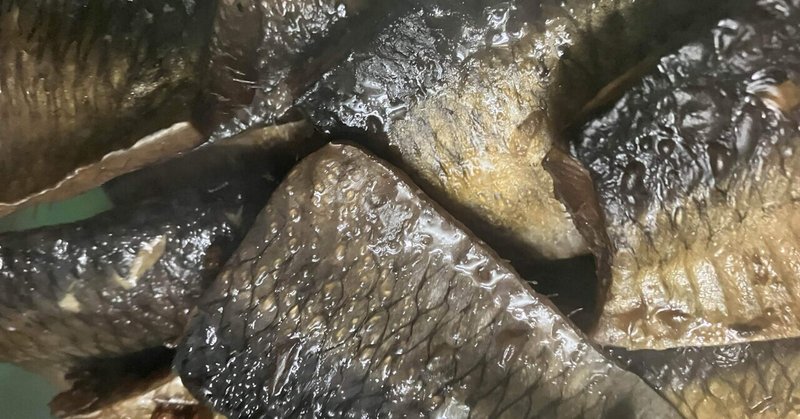
鰊のワイン煮 Simmered herring with wine
ストーリー Recipe trivia
世界の歴史に最も大きな影響を与えた魚は鰊かもしれない。この魚はとてつもなく大きな群を形成し定期的に北の海の沿岸に押し寄せる。捕獲できる数が半端ではないので、庶民のタンパク源としてまた肥料として、一国の経済を左右するくらいの流通量を生み出したからだ。中世ヨーロッパで勢力を誇ったハンザ同盟の主要交易品は鰊の塩漬けだったし、江戸時代から明治時代にかけて日本の農業生産を陰で支えたのは乾燥鰊だった。
Herring may be the fish that has had the greatest impact on world history. This fish forms enormous schools and periodically swarms along the coasts of the northern seas. The sheer numbers that can be caught are so large that they provide a source of protein for the common people and as fertilizer, generating a trade volume that could affect the economy of a country. Salted herring was the main trading item of the powerful Hanseatic League in medieval Europe, and dried herring was the secret ingredient in agricultural production in Japan from the Edo period to the Meiji period.
近代日本では、北海で鰊が大量に水揚げされると、食用に身欠鰊と数の子、灯火用に魚油、肥料用に鰊粕が大量に生産され、当時の海上輸送の大動脈だった「北前船」という日本海航路を通して北海から、東北や北陸を経由して当時日本経済の中心地だった京都、大阪、瀬戸内海に送り出された。通常は肉食をしなかった日本庶民にとっては常温保存できる貴重なタンパク源であり山間部まで流通した。鰊漁の繁栄は遠い昔の物語になってしまったけれど、漁場の南限が北へ移動し、ロシアやアラスカなどから輸入しなくてはならなくなっても、今でも東北、北陸、関西の伝統料理にしっかり組み込まれている。
身欠鰊は水で戻して醤油で煮たり漬物にすることが多いのだけど、これは、洋酒を出すことが多い深夜のバーの軽食用にワインを使ってアレンジしたもの。生鰊は上品とは言えない庶民の味だけど、丁寧に戻した乾燥鰊は割烹でも使える味に昇華させることができる。生のものとは別の食材と考えても良いのかもしれない。
In early modern Japan, when large quantities of herring were landed in the North Sea, they produced large quantities of "migakinishin" (dried herring without bones and organs) and "kazunoko" (salted eggs) for food, "fish oil" for lighting, and "nishinkasu" (dried pomace after squeezing oil from herring) for fertilizer. They were sent to Tohoku and Hokuriku via the "Kitamaebune" sea route, which was the main artery of maritime transport at the time, and to Kyoto, Osaka, and the Seto Inland Sea, which were the centers of the Japanese economy at the time. For ordinary Japanese people who did not normally eat meat, dried herring was a valuable source of protein that could be stored at room temperature, and was distributed even in mountainous areas. The prosperity of herring fishing is a story of the distant past, but even now, even though the southern limit of the fishing grounds has moved north and it has become necessary to import herring from Russia, Alaska, and other places, it is firmly integrated into the traditional cuisine of Tohoku, Hokuriku, and Kansai. Herring is often soaked in water and simmered in soy sauce or made into pickles, but this version uses wine and is intended as a snack in late-night bars, where Western alcoholic beverages are often served. Raw herring is a commoner's dish that cannot be described as refined, but carefully rehydrated dried herring can be elevated to a flavor that can be used in traditional Japanese cuisine. It may be better to think of it as a different ingredient.
Ingredients:
材料:
身欠鰊※
昆布
白ワイン
ブラックベリージャム
バルサミコ酢
薄口醤油
花椒
※ここでは上乾を使っているが、ソフトタイプでも良い
Dried herring※
Konbu kelp
White wine
Blackberry jam
Balsamic vinegar
Light type soy sauce
Szechuan pepper
※I use the high-grade dried herring here, but semi-dried herring is fine too.
procedure:
手順:
身欠鰊をバットなどに入れて水を注ぎ固く乾いた鰊を戻す。水に筍の灰汁抜きの要領で、少量の米粒か澱粉類を入れてやると、えぐみの元になる成分を吸着させることができる。上乾のものだと、冷蔵庫で管理しながら3日から1週間程度かかる。急ぐ時は一晩水で戻した後に蕨の灰汁抜きの要領で、熱い番茶を注いで冷めるまで放置すると翌日には使える。その時間もない人は、ここまでまとめて戻して冷凍しておくか、水で戻す必要のないソフトタイプの身欠鰊を使おう。
戻した鰊は、お湯を回しかけて酸化した脂を取り除き、鱗がついている場合はそれをしごいて取り、腹骨と背中のヒレを除き、エラと尻尾を落として、2、3当分に切り分けておく。
厚手の鍋に昆布を敷き、切り分けた鰊を並べ、水を材料が被るくらい入れる。白ワイン、ブラックベリージャム、バルサミコ酢、少量の薄口醤油で調味し、花椒を散らし、落とし蓋をして加熱する。沸騰したらやや強めの弱火にして、焦がさないように煮汁がほぼなくなるまで煮る。
食事の組み立てで、冷菜の前菜でも、他の素材と合わせて温めて提供しても良い。
ここまま冷蔵庫で1週間保管できる。
Place the dried herring in a tray and pour in water to soak until it is firm and dry. Adding a small amount of rice grains or starch to the water will help absorb the bitter components. For high-grade dried herring, it will take about three days to a week if kept in the refrigerator. If you are in a hurry, soak it overnight, then pour in hot bancha tea, and leave it until it cools down, and it will be ready to use the next day. If you don't have time, you can soak it up to this point and freeze it, or use semi-dried herring that does not need to be soaked in water.
Pour hot water over the rehydrated herring to remove oxidized fat. Remove any scales, remove the abdominal bones and back fins, discard the gills and tail, and cut into 2 or 3 equal pieces.
Place kelp in a thick-bottomed pot, arrange the cut herring, and add enough water to cover the ingredients. Season with white wine, blackberry jam, balsamic vinegar, a small amount of light type soy sauce and chinese pepper, then cover with otoshi-buta(drop-lid) and heat. Once boiling, reduce heat to slightly high and simmer until most of the liquid has evaporated, being careful not to burn.
It can be served as a cold appetizer or heated with other ingredients when assembling a meal.
It can be stored in the refrigerator as is for up to one week.


Tips and tricks:
コツと応用のヒント:
個人的には小骨があった方が好みですが、小骨も丁寧に抜くと更に上品な仕上がりになります。
ここではたまたま自家製ブラックベリージャムがあったので使っていますが、お好きなジャムや蜂蜜に替えてください。季節なら生のベリー類でも美味しくできます。甘味を加えたくない場合は省略しても構いません。
バルサミコ酢はコクと酸味を足すために使っていますが、無くても構いません。代わりに少量のリンゴ酢などを入れるのも良いでしょう。
アクセントに花椒を使っていますが、青椒を使うとまた違った趣に仕上がりますので、お好みの方で。ホールの胡椒など、お好みのスパイスに置き換えても良いでしょう。
昆布と薄口醤油で和のニュアンスを出していますが、塩だけの味付けでも十分美味しく仕上がります。僕は日本の濃口醤油は主張が強すぎて洋酒に合わないのと鰊自体の味わいをを楽しみたいと思うので、ここでは使っていません。もし、日本酒に合わすのなら、白ワインを日本酒に置き換えて、濃い味がお好みなら薄口醤油を濃口醤油に置き換えても良いでしょう。
常備菜として作っておき、季節野菜の煮物やピクルスを添えれば、突き出しの洒落た一皿になります。
Personally, I prefer it with small bones, but if you carefully remove them, the dish will be even more refined.
I happened to have homemade blackberry jam, so I used it here, but you can use your favorite jam or honey instead. If it's in season, fresh berries will also be delicious. If you don't want to add sweetness, you can omit it.
I use balsamic vinegar to add richness and acidity, but it's not necessary. You can also add a small amount of apple cider vinegar instead.
I use Sichuan peppercorns as an accent, but if you use green peppercorns, it will have a different flavor, so use whichever you prefer. You can also replace it with your favorite spices, such as whole peppercorns.
I use kelp and light soy sauce to give it a Japanese nuance, but it will be delicious enough with just salt. I don't use Japanese dark soy sauce here because it's too strong and doesn't go well with Western alcohol, and I want to enjoy the taste of the herring itself. If you want to pair it with sake, you can replace the white wine with sake, and if you like a strong flavor, you can replace the light soy sauce with dark soy sauce.
Keep it prepared as a staple dish, and if you add some stewed seasonal vegetables or pickles it makes a stylish appetizer dish.
Guide to where to find ingredients 材料入手先ガイド
この記事が気に入ったらサポートをしてみませんか?
